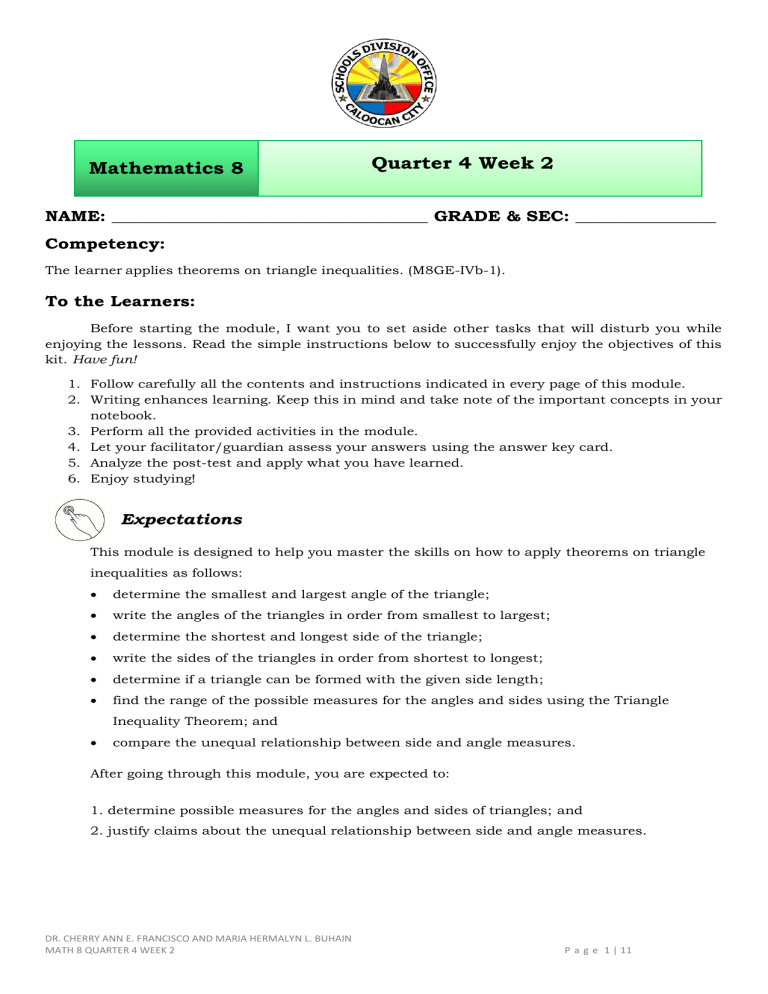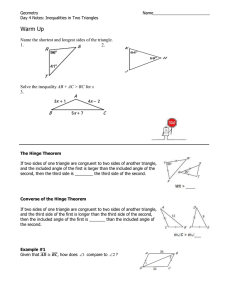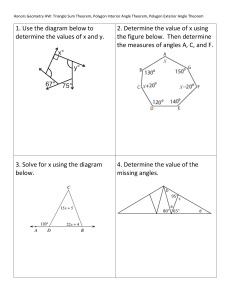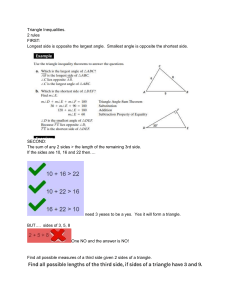
Mathematics 8 Quarter 4 Week 2 NAME: ____________________________________ GRADE & SEC: ________________ Competency: The learner applies theorems on triangle inequalities. (M8GE-IVb-1). To the Learners: Before starting the module, I want you to set aside other tasks that will disturb you while enjoying the lessons. Read the simple instructions below to successfully enjoy the objectives of this kit. Have fun! 1. Follow carefully all the contents and instructions indicated in every page of this module. 2. Writing enhances learning. Keep this in mind and take note of the important concepts in your notebook. 3. Perform all the provided activities in the module. 4. Let your facilitator/guardian assess your answers using the answer key card. 5. Analyze the post-test and apply what you have learned. 6. Enjoy studying! Expectations This module is designed to help you master the skills on how to apply theorems on triangle inequalities as follows: • determine the smallest and largest angle of the triangle; • write the angles of the triangles in order from smallest to largest; • determine the shortest and longest side of the triangle; • write the sides of the triangles in order from shortest to longest; • determine if a triangle can be formed with the given side length; • find the range of the possible measures for the angles and sides using the Triangle Inequality Theorem; and • compare the unequal relationship between side and angle measures. After going through this module, you are expected to: 1. determine possible measures for the angles and sides of triangles; and 2. justify claims about the unequal relationship between side and angle measures. DR. CHERRY ANN E. FRANCISCO AND MARIA HERMALYN L. BUHAIN MATH 8 QUARTER 4 WEEK 2 P a g e 1 | 11 Pre-test Choose the letter of the correct answer. Write the chosen letter on a separate sheet of paper. 1. Which side of ∆ 𝑀𝐴𝑇 is the shortest? ̅̅̅̅̅ A. 𝑀𝐴 ̅̅̅̅̅ C. 𝑀𝑇 ̅̅̅̅ B. 𝐴𝑇 D. it cannot be determined 2. In ∆RUN, RU = 24 cm, UN = 8 cm, and RN = 30 cm. List the angles in order from largest to smallest measure. A. ∠ 𝑅, ∠ 𝑈, ∠ 𝑁 B. ∠ 𝑈, ∠ 𝑅, ∠ 𝑁 C. ∠ 𝑈, ∠ 𝑁, ∠ 𝑅 D. ∠ 𝑁, ∠ 𝑅, ∠ 𝑈 C. 9 D. 7 c. 12< x < 39 d. 12< x < 50 3. What is the possible value of x? A. 11 B. 10 4. What is the range of the possible value of x? a. -12< x < 39 b. -15< x < 39 5. What is the range of possible value for x? a. -4< x < 16 c. -4< x < 20 b. 4< x < 16 d. -10< x < 20 Looking Back to your Lesson AGAIN!! WHICH IS WHICH? Directions: Given the following theorems on triangle inequalities in one triangle and triangle inequalities in two triangles, a. Triangle Inequality theorem 1 (SS→AA) b. Triangle Inequality theorem 2 (AA→SS) c. Triangle Inequality theorem 3 (S1+S2 > S3) d. Exterior-Angle Inequality Theorem (Exterior ∠ > Remote Interior ∠) e. Hinge Theorem or SAS inequality Theorem f. Converse of Hinge Theorem or SSS inequality Theorem Identify what corresponding illustration for each of the triangle inequalities. _____1. The sum of the lengths of any two sides of a triangle is greater than the length of the third side. _____2. If one angle of a triangle is larger than a second angle, then the side opposite the first angle is longer than the side opposite the second angle. _____3. If two sides of one triangle are congruent to two sides of another triangle, but the included angle of the first triangle is greater than the included angle of the second, then the third side of the first triangle is longer than the third side of the second. _____4. If one side of a triangle is longer than a second side, then the angle opposite the first side is larger than the angle opposite the second side. _____5. The measure of an exterior angle of a triangle is greater than the measure of either remote interior angle. _____6. If two sides of one triangle are congruent to two sides of another triangle, but the third side DR. CHERRY ANN E. FRANCISCO AND MARIA HERMALYN L. BUHAIN MATH 8 QUARTER 4 WEEK 2 P a g e 2 | 11 of the first triangle is longer than the third side of the second, then the included angle of the first triangle is larger than the included angle of the second. Introduction of the Topic Lesson 1: Applies Theorems on Triangle Inequalities PROPER CONSTRUCTION IS IMPORTANT!!! In a construction site, you are the engineer who is going to determine if the constructed triangular bases of a bridge are identically balance and you observed that some of the triangular bases look different. How can you prove that your observation is right? Based on the situation, application on triangle inequalities will be utilized for you to prove what you have observed. Balance and proportion are very This Photo by Unknown Author is licensed under CC BYSA-NC important in the construction industry, for if you will not consider these things accident may happen or worse can cause death to the people who utilize the constructed things. Applying concepts on theorems on triangle inequalities (Triangle Inequality Theorem 1, Triangle Inequality Theorem 2, Triangle Inequality Theorem 3, Exterior-Angle Inequality Theorem, Hinge Theorem or SAS Inequality Theorem, and Converse of Hinge Theorem or SSS Inequality Theorem) are very useful in checking properties of triangle-shaped objects. Again, here are the theorems on triangle inequalities. Inequalities in One Triangle: 1. Triangle Inequality Theorem 1 (Ss → 𝑨𝒂) Example 1: Cite angles and sides relationship shown in the given triangle. ̅̅̅̅ 𝐴𝐵 > ̅̅̅̅ 𝐵𝐶 , So m∠ 𝐶 > m∠ 𝐴 Example 2: Name the smallest and largest angle of the triangle. Largest angle: ∠𝑀 Smallest angle: ∠𝐾 Example 3: Write the angles of the triangles from smallest to largest order. ̅̅̅̅ 𝐵𝐶 < ̅̅̅̅ 𝐴𝐵 < ̅̅̅̅ 𝐴𝐶 , So m∠ 𝐴 < m∠ 𝐶 < m∠ 𝐵 Angle: ∠ 𝐴, ∠ 𝐶, ∠ 𝐵 2. Triangle Inequality Theorem 2 (Aa → 𝑺𝒔) Example 1: Name the shortest and longest side of the triangle. Since the m∠𝐵 = 1000, m∠𝐶 = 500, and m∠𝐴 = 300, therefore the shortest side is ̅̅̅̅ 𝐵𝐶 and the longest side is ̅̅̅̅ 𝐴𝐶 . Example 2: Write the sides of the triangle from shortest to longest measure. Solution: Since 𝑚∠ 𝐸= 610 and 𝑚∠ 𝐹= 590, By the Triangle Sum Theorem: find 𝑚∠ 𝐷 DR. CHERRY ANN E. FRANCISCO AND MARIA HERMALYN L. BUHAIN MATH 8 QUARTER 4 WEEK 2 P a g e 3 | 11 m∠ 𝐷 = 1800 – (𝑚∠ 𝐸 + 𝑚∠ 𝐹) m∠ 𝐷 = 1800 – (610 + 590) m∠ 𝐷 = 1800 – (1200) = 600 𝑚∠ 𝐹 < 𝑚∠ 𝐷 < 𝑚∠ 𝐸, So ̅̅̅̅ 𝐷𝐸 < ̅̅̅̅ 𝐸𝐹 < ̅̅̅̅ 𝐷𝐹 Side: ̅̅̅̅ 𝐷𝐸, ̅̅̅̅ 𝐸𝐹 , ̅̅̅̅ 𝐷𝐹 Example 3: List the angles and sides of each triangle from smallest/shortest to largest/longest measure. Solution: Using the Triangle Sum Theorem, we can solve for x, as shown below. (2x + 9) + (2x + 1) + 90 = 180 Triangle Sum Theorem 4x + 100 = 180 combine like terms 4x = 80 APE, add (– 100) to both sides x = 20 MPE, divide both sides by 4 m∠𝑋 = 2 (20) + 1 = 410, and m∠𝑌 = 2 (20) + 9 = 490. Therefore, m∠𝑋 < m∠𝑌 < m∠𝑍, we know that the length of sides across larger angles are longer than those across from shorter angles so ̅̅̅̅ 𝑌𝑍 < ̅̅̅̅ 𝑋𝑍 < ̅̅̅̅ 𝑋𝑌 . ̅̅̅̅, 𝑋𝑍 ̅̅̅̅, 𝑋𝑌 ̅̅̅̅ Side: 𝑌𝑍 Angle: ∠ 𝑋, ∠ 𝑌, ∠ 𝑍 3. Triangle Inequality Theorem 3 (S1 + S2 > S3) Example 1: Determine if a triangle can be formed with the given side length. Explain your answer. a. 4, 8, 10 Solution: 4+8 ? 10 > 4 + 10 12 > 10 True ? 8 > 8 + 10 14 > 8 True ? 4 > 18 > 4 True Conclusion: The sum of each pair of side lengths is greater than the third length. So, a triangle can have side lengths of 4, 8, and 10. b. 7, 9, 18 Solution: 7+9 ? 18 > 7 + 18 16 > 18 False ? 9 > 9 + 18 25 > 9 True ? 7 > 27 > 7 True Conclusion: Not all three inequalities are true. So, a triangle cannot have these three side lengths. Example 2: Find the range of values for x using the Triangle Inequality Theorem. Solution: x + 14 > 21 x>7 21 + 14 > x x + 21 > 14 35 > x x > -7 Ignore the inequality with a negative value since a triangle cannot have a negative side length. Combine the inequalities. So, the length of the third side is greater than 7 and less than 35, (7 < x < 35) Example 3: Find the range of values for x using the Triangle Inequality Theorem. Solution: DR. CHERRY ANN E. FRANCISCO AND MARIA HERMALYN L. BUHAIN MATH 8 QUARTER 4 WEEK 2 P a g e 4 | 11 (x + 2) + 10 > 12 (x + 2) + 12 > 10 10 + 12 > x + 2 x + 12 > 12 x + 14 > 10 22 > x + 2 x>0 x > -4 20 > x Combine the inequalities. Hence, 0 < x < 20. The length of the third side is greater than 0 and less than 20. 4. Exterior Angle Inequality Theorem Use the Exterior Angle Inequality Theorem to answer the following. Example 1: Show angles that is less than m∠ 4 Solution: By the Exterior Angle Inequality Theorem, the exterior angle ∠ 4 is larger than either the two remote interior angles (∠ 1 and ∠ 2). Also, m∠ 4 + m∠ 3 = 180, and (m∠ 1 + m∠ 2) + m∠ 3 = 180. By transitivity, m∠ 4 = (m∠ 1 + m∠ 2). Therefore, ∠ 4 must be larger than each individual angle. By the Exterior Angle Inequality Theorem, m∠ 𝟒 > 𝑚∠ 1 and m∠ 𝟒 > 𝒎∠ 𝟐. Answer: ∠ 𝟏, ∠ 𝟐 Example 2: Find the possible value of x. Solution: Find x ∠ 𝑥 > 500; ∠ 𝑥 > 600, however you know x = sum of the remote interior angle. Therefore, 600 < x < 1800. Example 3: Find the restrictions on x. Solution: 30 < 3x – 18 EAI Theorem 3x – 18 < 180 48 < 3x add both sides by 18 3x < 198 add both sides by 18 16 < x divide both sides by 3 x < 66 divide both sides by 3 Therefore, 16 < x < 66. Inequalities in Two Triangles: 1. Hinge Theorem or SAS Inequality Theorem ̅̅̅̅ and 𝑌𝑍 ̅̅̅̅. Example 1: Compare 𝐵𝐶 Solution: ̅̅̅̅ ≅ 𝑋𝑌 ̅̅̅̅, 𝐴𝐶 ̅̅̅̅ ≅ 𝑋𝑍 ̅̅̅̅ and 𝑚∠ 𝐵𝐴𝐶 > 𝑚∠𝑌𝑋𝑍; then 𝑩𝑪 ̅̅̅̅ > 𝒀𝒁 ̅̅̅̅. If 𝐴𝐵 Example 2: Compare ̅̅̅̅ 𝐸𝐹 and ̅̅̅̅ 𝐺𝐹. Solution: Compare the sides and angles in ∆ 𝐸𝐹𝐻 angles in ∆ GFH. m∠𝐺𝐻𝐹 = 1800 – 820 = 980. ̅̅̅̅ 𝐸𝐻 = ̅̅̅̅ 𝐺𝐻 ̅̅̅̅ 𝐹𝐻 = ̅̅̅̅ 𝐹𝐻 𝑚∠ 𝐸𝐻𝐹 > 𝑚∠𝐺𝐻𝐹. By the Hinge Theorem, ̅̅̅̅ 𝑬𝑭 < ̅̅̅̅̅ 𝑮𝑭. Example 3: Solve for the possible values of x. Solution: x + 23 > 3x + 9 (theorem) -2x > -14 (combine like terms) DR. CHERRY ANN E. FRANCISCO AND MARIA HERMALYN L. BUHAIN MATH 8 QUARTER 4 WEEK 2 3x + 9 > 0 3x > -9 (add both sides by -9) P a g e 5 | 11 x< 7 (divide both sides by -2) x > -3 (divide both sides by 3) Therefore, -3 < x < 7. 2. Converse of Hinge Theorem or SSS Inequality Theorem Example 1: Compare 𝑚∠ 𝐵𝐴𝐶 and 𝑚∠𝐷𝐴𝐶 Solution: Compare the side length in ∆ 𝐴𝐵𝐶 and ∆ ADC. ̅̅̅̅ 𝐴𝐵 = ̅̅̅̅ 𝐴𝐷 ̅̅̅̅ 𝐴𝐶 = ̅̅̅̅ 𝐴𝐶 ̅̅̅̅ 𝐵𝐶 > ̅̅̅̅̅ 𝐷𝐶 By the Converse of the Hinge Theorem, m∠𝐵𝐴𝐶 > 𝑚∠𝐷𝐴𝐶. Example 2: Find the range of values for k. Solution: Step 1: Compare the side length in ∆ 𝑀𝐿𝑁 and ∆ PLN. ̅̅̅̅ 𝐿𝑁 = ̅̅̅̅ 𝐿𝑁 ̅̅̅̅ = ̅̅̅̅ 𝐿𝑀 𝐿𝑃 ̅̅̅̅̅ > ̅̅̅̅̅ 𝑀𝑁 𝑃𝑁 By the Converse of the Hinge Theorem, m∠𝑀𝐿𝑁 > 𝑚∠𝑃𝐿𝑁. 5k – 12 < 38 k < 10 (substitute the given values) (add 12 to both sides and divide by 5) Step 2: Since ∠𝑃𝐿𝑁 is in a triangle, m∠𝑃𝐿𝑁 > 00. 5k – 12 > 0 k < 2.4 (substitute the given values) (add 12 to both sides and divide by 5) Step 3: Combine the two inequalities. The range of values for k is 2.4 < k < 10. Activities ACTIVITY 1: MEASURES MATTERS! Directions: Given the illustrated triangles and corresponding measurements, A. Identify the largest angle and the smallest angle then write the angles of the triangles from smallest to largest order. Triangle 1 ∆ABC 2 ∆DEF 3 ∆CAB Largest Smallest Angle Angle Order of angle measures from smallest to largest: 1. ____________________ 2. ____________________ 3. ___________________ B. Identify the longest side and the shortest side then write the sides of the triangles in order from shortest to longest. Triangle 1 2 3 Longest Side ∆ABC ∆LMN ∆DEF Order of side lengths from shortest to longest: DR. CHERRY ANN E. FRANCISCO AND MARIA HERMALYN L. BUHAIN MATH 8 QUARTER 4 WEEK 2 P a g e 6 | 11 Shortest Side 1. ____________________ 2. ____________________ 3. ___________________ C. RAMPS. The wedge at the right represents a skateboard ramp. Which is ̅̅̅̅? longer, the length of the ramp ̅̅̅̅ 𝐾𝐴 or the length of the top surface of ramp 𝑆𝐴 Explain your answer. ________________________________________________________ ACTIVITY 2: A TRIANGLE OR NOT? A. Determine whether the given measures can be the lengths of the sides of a triangle. Write Yes or No. _______ 1. 5, 4, 3 _______ 6. 12, 15, 18 _______ 2. 5, 15, 10 _______ 7. 13, 14, 29 _______ 3. 30.1, 0.8, 31 _______ 8. 17, 30, 30 _______ 4. 8.4, 7.2, 3.5 _______ 9. 9, 21, 20 _______ 5. 5, 17, 9 _______10. 18, 32, 21 B. Find the range of values for x using the Triangle Inequality Theorem. _____________ 1. 7, 12 and x _____________ 4. 15, 18 and x _____________ 2. 14, 23 and x _____________ 5. 10, 14 and 2x + 2 _____________ 3. 22, 34 and x C. Mrs. Barreto has a pet rabbit and wants to build a pen for it. She has 3 pieces of lumber: one is 3 ft, one is 7 ft, and the other is 8 ft long. Can she build a closed triangular pen with these three lumbers (will the lumbers form a triangle)? Explain your answer. ________________________ _______________________________________________________________________________________________ ACTIVITY 3: GREATEST OF THEM ALL! Determine which angle has the greatest measure. Write your answer on the space provided. _______ 1. ∠ 1, ∠ 2, ∠ 4 _______ 4. ∠ 5, ∠ 7, ∠ 8 _______ 2. ∠ 1, ∠ 2, ∠ 6 _______ 5. ∠ 5, ∠ 6, ∠ 8 _______ 3. ∠ 3, ∠ 5, ∠ 7 ACTIVITY 4: FINDING “x”. Find the range of the possible values for x. 1. 2. _________________ 3. _________________ _________________ ACTIVITY 5: COMPARE US! Write an inequality relating the given pair of angles or segment measures. Complete each statement by writing <, =, or >. ̅̅̅̅ ______ 𝑃𝑁 ̅̅̅̅ 1. 𝐿𝑀 ̅̅̅̅ ______ 𝐷𝐶 ̅̅̅̅ 2. 𝐴𝐷 DR. CHERRY ANN E. FRANCISCO AND MARIA HERMALYN L. BUHAIN MATH 8 QUARTER 4 WEEK 2 ̅̅̅̅ ______ 𝑁𝐾 ̅̅̅̅̅ 3. 𝑆𝑇 ̅̅̅̅ ______ 𝐼𝐽 ̅ 4. 𝐻𝐼 P a g e 7 | 11 5. 𝑚∠𝐶𝐴𝐵 ______ 𝑚∠𝐶𝐵𝐴 6. 𝑚∠1 ______ 𝑚∠2 7. 𝑚∠1 ______m∠2 8. 𝑚∠𝐴 _____m∠𝐵 ACTIVITY 6: SOLVE ME! Use the Hinge Theorem or its converse and properties of triangle to write and solve an inequality to describe the restriction on the value of x. 1. 2. 3. 4. 5. Remember You have learned the following theorems on Triangle inequalities: Inequalities in One Triangle: 1. Triangle Inequality Theorem 1 (Ss → 𝐴𝑎) 2. Triangle Inequality Theorem 2 (Aa → 𝑆𝑠) 3. Triangle Inequality Theorem 3 (S1 + S2 > S3) 4. Exterior Angle Inequality Theorem Inequalities in Two Triangles: 1. Hinge Theorem or SAS Inequality Theorem 2. Converse of Hinge Theorem or SSS Inequality Theorem Check your Understanding Directions: Identify the theorem to be applied in the given situations/problems, then solve if necessary. Write your answer on the space provided. 1. If the measures of the two sides a triangle is 15 and 26, what are the possible measures of the third side? __________________________________ 2. If AB = 7cm, BC = 8cm and AC = 13cm. Which among the angles is the largest? _________________ 3. If the measures of the two angles of ∆KIT are ∠K = 75˚ and ∠I = 32˚, what is the longest side? __________________________________ 4. List the sides of ∆PQR in order from longest to smallest if the angles of ∆PQR have the given measures: m∠𝑃 = 7x + 8, m∠𝑄 = 8x – 10, m∠𝑅 = 7x + 6. ______________________________ 5. The side lengths of ∆NFL are NF = 17, FL = 19, and NL = 10x - 11. Determine the possible DR. CHERRY ANN E. FRANCISCO AND MARIA HERMALYN L. BUHAIN MATH 8 QUARTER 4 WEEK 2 P a g e 8 | 11 values of x. __________________________________ 6. Using the figure and the Inequality Theorem, which angle, ∠5 or ∠8, has the smallest measure? _____________________________________ 7. Using the figure and the Inequality Theorem, which angle, ∠1, ∠6 or ∠9, has the greatest measure? ____________________________________ Use the figure at the right. ̅̅̅̅ = 𝐸𝐻 ̅̅̅̅ and m∠FEG > m∠FEH, which is longer, 𝐻𝐹 ̅̅̅̅ or 𝐺𝐹 ̅̅̅̅ ? ____________________ 8. If 𝐸𝐺 ̅̅̅̅ = 𝐸𝐻 ̅̅̅̅ and 𝐺𝐹 ̅̅̅̅ < 𝐻𝐹 ̅̅̅̅ , which is larger, ∠GEF or ∠HEF? ________________________ 9. If 𝐸𝐺 10. Solve an inequality to describe a restriction on the value of x. ______________________ Post-Test Choose the letter of the correct answer. Write the chosen letter on a separate sheet of paper. 1. Which side of ∆ 𝑀𝐴𝑇 is the shortest? a. ̅̅̅̅̅ 𝑀𝐴 c. ̅̅̅̅̅ 𝑀𝑇 b. ̅̅̅̅ 𝐴𝑇 d. it cannot be determined 2. In ∆RUN, RU = 24 cm, UN = 8 cm, and RN = 30 cm. List the angles in order from smallest to largest measure. a. ∠ 𝑅, ∠ 𝑈, ∠ 𝑁 b. ∠ 𝑈, ∠ 𝑅, ∠ 𝑁 c. ∠ 𝑈, ∠ 𝑁, ∠ 𝑅 d. ∠ 𝑁, ∠ 𝑅, ∠ 𝑈 c. 9 d. 7 c. 12< x < 39 d. 12< x < 50 3. What is the possible value of x? a. 11 b. 10 4. What is the range of the possible value of x? a. -12< x < 39 b. -15< x < 39 5. What is the range of possible value for x? a. -4< x < 16 c. -4< x < 20 b. 4< x < 16 d. -10< x < 20 Additional Activities To better understand the lesson, watch the video lesson on https://www.youtube.com/watch?v=3vOfQnUjzV8 entitled “Triangle Inequality Theorem” and https://www.youtube.com/watch?v=YHwSe-0c7Xo entitled “Hinge Theorem Inequalities 2 Triangles”. Reflection At the beginning of the lesson, I couldn’t _______________________________ _______________________________________________________________________ But now I can _________________________________________________________ _______________________________________________________________________ Here’s how I did it: ___________________________________________________ _______________________________________________________________________ What this means for my learning next year? ____________________________ _______________________________________________________________________ DR. CHERRY ANN E. FRANCISCO AND MARIA HERMALYN L. BUHAIN MATH 8 QUARTER 4 WEEK 2 P a g e 9 | 11




